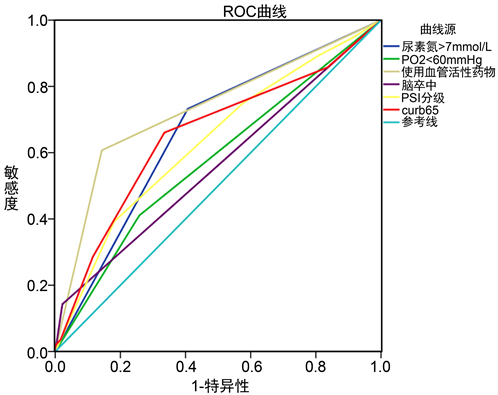摘要:
目的:为了比较入住重症监护室(intensive care unit, ICU)的肺炎旁胸腔积液(Parapneumonic pleural effusion, PPE)患者临床特征、实验室数据、病原菌分布及影响住院30天病死率的危险因素。方法:本研究为多中心回顾性观察性研究,包括2014.01.01~2014.12.31期间我国13个不同地区的多家医院住院(Community-acquired pneumonia, CAP)患者临床数据。筛选出入住ICU的并有胸腔积液的CAP患者,根据患者30天内有无死亡,分为生存组和死亡组,比较两组患者的临床资料、病原学特征、治疗、病死率。最后采用多因素分析影响患者的住ICU的30天病死率的危险因素。结果:270例PPE患者入住ICU,年龄中位数是74.0岁,男性164例(60.7%)。住院30天内生存患者207例(76.7%),年龄中位数为72.0 (60.0~82.0)岁,死亡患者63例(23.3%),年龄中位数为75.0 (61.0~84.0)岁,两组均男性偏多,死亡患者易出现意识改变,PO
2 < 60 mmHg,尿素氮≥7 mmol/L,并发症发生率高。入住ICU患者主要培养菌为肺炎克雷伯杆菌(9.6%),其次是金黄色葡萄球菌(4.1%);死亡患者机械通气率,并发症发生率,应用血管活性药物概率均高于生存组。多因素分析显示影响入住ICU的PPE患者30天病死率的危险因素为尿素氮≥7 mmol/L (OR 3.102, 95% CI 1.220~7.887),PO
2 < 60 mmHg (OR 2.634, 95% CI 1.100~6.309),应用血管活性药物(OR 7.239, 95% CI 2.999~17.475),脑卒中(OR 6.548, 95% CI 1.211~35.407)。结论:影响入住ICU的PPE患者30天病死率的危险因素为尿素氮>7 mmol/L,PO
2 < 60 mmHg,应用血管活性药物,出现脑卒中;临床医生应该注意识别患者危险因素,及时采取合理的治疗措施,降低患者病死率。
Abstract:
Objective: To compare the clinical characteristics, laboratory data, pathogenic bacteria distribution and risk factors for 30-day mortality of patients with Parapneumonic pleural effusion (PPE) admitted to intensive care units (ICU). Method: This is a multicenter retrospective observational study, including clinical data of community-acquired pneumonia (CAP) patients hospitalized in hospitals in 13 different regions of China during 2014.01.01 - 2014.12.31. The CAP patients admitted to the ICU with pleural effusion were screened into survival group and death group according to whether the patients died within 30 days. The clinical data, etiological characteristics, treatment and fatality rate of the two groups were compared. Finally, a multivariate analysis was performed to determine the risk factors affecting the 30-day fatality rate. Result: There were 270 PPE patients admitted to ICU with a median age of 74.0 years and 164 males (60.7%). 207 patients (76.7%) survived within 30 days of hospitalization, with a median age of 72.0 (60.0 - 82.0) years; 63 patients (23.3%) died, with a median age of 75.0 (61.0 - 84.0) years. Both groups had more males, and the patients who died were prone to consciousness changes, PO2 < 60 mmHg, urea nitrogen ≥ 7 mmol/L, and a high incidence of complications. The main culture bacteria of ICU patients were Klebsiella pneumoniae (9.6%), followed by Staphylococcus aureus (4.1%). The rate of mechanical ventilation, complication rate and application of vasoactive agents in patients with death were higher than those in the survival group. Multivariate analysis showed that the risk factors for 30-day mortality of PPE patients admitted to ICU were urea nitrogen ≥ 7 mmol/L (OR 3.102, 95% CI 1.220 - 7.887), PO2 < 60 mmHg (OR 2.634, 95% CI 1.100 - 6.309), application of vasoactive agents (OR 7.239, 95% CI 2.999 - 17.475), stroke (OR 6.548, 95% CI 1.211 - 35.407). Conclusion: The risk factors affecting 30-day mortality of patients with PPE admitted to ICU are urea nitrogen ≥ 7 mmol/L, PO2 < 60 mmHg, vasoactive drugs, and stroke. Clinicians should pay attention to identify the risk factors of patients and take reasonable treatment measures in time to reduce the mortality of patients.
1. 引言
社区获得性肺炎仍是世界范围内常见的疾病之一 [1],肺炎患者住院早期死亡率约为住院期间死亡患者的三分之一,主要为老年人、意识改变或脓毒症休克患者 [2]。在过去10余年里,因呼吸道感染入住ICU人数显著增加,对ICU的需求不断增长 [3] [4]。虽然大部分患者早期应用抗生素治疗,但其死亡率仍然很高 [5],尤其是非肺炎链球菌肺炎和需要机械通气的患者 [6]。到目前为止,虽然与CAP相关的研究较为广泛,但是关于入住ICU的PPE患者病死率方面的研究较少。我们的研究主要是通过描述ICU的PPE患者的临床特征、合并症、实验室检查、病原菌分布、预后以及严重程度指标,评估这些指标是否与此类患者住院30天病死率有关。
2. 资料与方法
2.1. 研究人群
本研究是一项时间为2014.01.01~2014.12.31期间覆盖全国3省7市13家医院住院CAP患者的回顾性观察性研究。主要选择入住ICU的PPE患者,根据患者住院30天内是否死亡,分为生存组和死亡组,比较两组患者的临床资料、病原学特征、预后、严重程度指标。最后采用多因素分析影响此类死亡患者的30天病死率的危险因素。
2.2. 纳入/排除标准
纳入标准:1) 根据《社区获得性肺炎诊断和治疗指南(2016年版)》 [7] 诊断标准筛选出CAP患者:a) 社区发病;b) 胸部影像学检查显示片状、斑片状浸润性阴影、叶或段实变影或间质性改变;c) 肺炎相关临床表现:① 新近出现的咳嗽、咳痰或原有呼吸道疾病症状加重,伴或不伴脓痰、胸痛、呼吸困难及咯血;② 发热;③ 肺实变体征和(或)闻及湿性啰音;④ 外周血白细胞>10 × 109/L或<4 × 109/L,伴或不伴细胞核左移。符合以上1,2,3条和第4条中任何1项;2) >4岁;3) 合并胸腔积液;4) 入住ICU。排除标准:1) 患者初次确诊肺部肿瘤,其他脏器恶性肿瘤,或为肺结核、非感染性间质性肺疾病、肺水肿、肺不张、肺栓塞、肺嗜酸性粒细胞浸润症及肺血管炎等;2) 严重免疫抑制 [8],包括实体器官移植;对患有移植物抗宿主病的患者在近1年内或移植后的任何时间进行干细胞移植或骨髓移植;HIV;过去半年内接受化疗或近3个月内接受免疫抑制治疗(服用20 mg/天强的松或等效物当量,持续2周或更长时间);近1月内进行胸部放射治疗 [9];无脾脏;3) 患者出院72小时内再入院,归为一次住院;4) 妊娠或哺乳期妇女;5) 医院获得性肺炎。
本研究得到了当地伦理委员会的批准。
2.3. 研究方法
收集资料:人口统计学资料、入院/出院/死亡日期、合并疾病(慢性肝病、心血管疾病、慢性气道疾病、脑血管疾病和慢性肾病)、生命体征、实验室检查、动脉血气分析、影像学检查、病原体检测、有创或无创机械通气、需要血管活性药物、并发症等结果变量;使用PSI分级 [10]、CURB-65评分 [11] 评估患者病情严重程度。
2.4. 病原学检测
符合下列标准 [12],即可确定病原菌:1) 痰培养阳性,菌株呈中度以上生长;2) 血培养(不包括受污染的正常皮肤菌群)、胸腔积液培养、气道吸出物、肺泡灌洗液培养阳性;3) 肺炎链球菌和嗜肺军团菌尿抗原检测阳性;4) 肺炎支原体和肺炎衣原体等非典型病原体抗体增加4倍或4倍以上;或酶联免疫吸附法检测IgG/IgM抗体(+);5) 咽拭子抗原检测阳性。
2.5. 统计分析
分类变量用百分比表示,连续变量用平均值和标准差或中位数和四分位数范围表示。分类变量采用卡方检验或Fisher精确检验,连续变量采用T检验或U检验。p值<0.05被认为是显著的。将患者分为两组,首先对变量进行单因素分析,P值<0.1的变量再进入多因素分析。人口统计学信息和变量包括在单变量和多变量logistic回归模型中。统计分析采用SPSS19.0统计软件。
3. 结果
3.1. 人口学基础资料和预后
总共有270名PPE患者入住ICU,男性164例(60.7%),中位年龄为74.0 (61.0~82.0)岁,236例(87.4%)患者合并基础疾病,常见的合并症依次为心血管疾病(56.3%)、脑血管疾病(29.3%)、慢性气道疾病(20.7%)、糖尿病(20.7%),24例患者合并慢性肾脏病(8.9%)。入住ICU患者CURB-65和PSI评分为低风险比例分别为61.1%和39.3%。住院期间40.7%患者机械通气支持,有创通气患者占28.5%。在入院的最初72小时内,35名患者(13.0%)需要有创通气支持,6名患者(2.2%)因脓毒症性休克需要血管活性药物,总体ICU患者住院时间中位数为13.0 (8.0~22.0)天,住院14天病死率为9.6%。
根据PPE患者入住ICU 30天是否存活,将患者分为生存组和死亡组。存活患者207例(76.7%),死亡患者63例(23.3%),生存患者年龄为72.0 (60.0~82.0)岁,大约50%的死亡患者年龄在75岁以上,老年人占73.0%,易合并基础疾病,出现并发症、应用机械通气和血管活性药物治疗的比例高于存活患者,常表现为意识改变、低氧血症,高尿素氮水平,存活患者住院时间明显高于死亡患者(P<0.001)。两组患者其他基线特征和变量无显著差异。根据PSI评分和CURB-65分级,风险等级的级别越高,患者病死率越高,两组患者的人口统计学特征、临床数据和预后如表1所示。


Table 1. Demographic characteristics and prognosis of the two groups
表1. 两组患者人口统计学特征和预后
3.2. 病原学分布
总共83.7%患者进行病原体检测,包括痰、血液、肺泡灌洗液、胸水培养、尿抗原检测、血清抗原、抗体检测。细菌检出率为38.5% (n = 77),主要为肺炎克雷伯杆菌,其次是金黄色葡萄球菌。病毒检出率为9.6% ( n = 26),最常见的病毒为EB病毒。生存和死亡患者微生物检验结果见表2,死亡患者常见病原菌主要为肺炎克雷伯杆菌,在病原学分布方面两组患者无显著差异。由于本研究为回顾性研究,无法准确判断真菌是定植菌还是污染菌,故未进行细分。

Table 2. Distribution of pathogenic bacteria in two groups
表2. 两组患者病原菌分布情况
3.3. 住院30天病死率的危险因素分析
以入住ICU患者的住院30天病死率为主要结果,进行单因素logistic回归分析,如表3所示。死亡患者易表现为意识改变、PO2低和较高的尿素氮水平。通过对患者性别、年龄、PSI和CURB-65评分进行矫正后,多因素分析显示:PO2 < 60 mmHg (OR 2.634, 95% CI 1.100~6.309, P = 0.030)、尿素氮≥7 mmol/L (OR 3.102, 95% CI 1.220~7.887, P = 0.017)、应用血管活性药物(OR 7.239, 95%CI 2.999~17.475, P < 0.001)、脑卒中(OR 6.548, 95% CI 1.211~35.407, P = 0.029)与住院30天病死率显著相关,如表4所示。在预测住院30天病死率的ROC曲线上,以上危险因素判断能力如图1所示,使用血管活性药物预测病死率的曲线下面积最大,AUC为0.732,敏感度为0.607,特异度为0.857。


Table 3. Analysis of risk factors of 30-day mortality in ICU
表3. 住ICU 30天病死率的危险因素分析

Table 4. Multivariate analysis of 30-day mortality in ICU
表4. 住ICU 30天病死率的多因素分析

Figure 1. ROC curve of risk factors affecting 30-day mortality of PPE patients in ICU
图1. 影响PPE患者ICU住院30天病死率的危险因素ROC曲线
4. 讨论
本研究中,所有收治ICU的患者都接受了抗生素的基础治疗,但患者住院30天病死率仍较高。既往研究表明,入住ICU的肺炎患者住院时间和病死率显著高于普通病房患者 [13]。本研究纳入270例PPE患者,血清尿素氮水平高、PO2低、住院期间使用血管活性药物、出现脑卒中是影响入住ICU的PPE患者30天病死率的危险因素。所以,临床医生应早期识别患者的危险因素,评估患者的呼吸、肾脏等脏器功能状态,及时采取合理的干预措施,降低死亡率。
死亡患者合并基础疾病的比例高达92.1%,合并慢性肾病比例显著高于存活患者(P = 0.026)。此外,与存活患者相比,死亡患者住院期间往往出现意识改变、低氧血症和高水平尿素氮。通过分析发现,影响入住ICU的PPE患者30天病死率潜在机制包括缺氧、尿素氮水平升高、代谢紊乱等因素。韩国一项回顾性研究发现PPE患者病程中出现低氧血症、低蛋白血症、贫血等并发症 [14] 是延长住院时间的危险因素,严重者可出现呼吸衰竭甚至危及生命。由于较低的PO2可能反映通气不足或通气–血流灌注失调,预示着肺实变较严重,它可能与败血症或呼吸窘迫综合征有关 [15]。
最近一项纳入1834例CAP患者的回顾性研究表示尿素氮水平高、低蛋白血症、PaO2/FiO2 ≤ 250 mmHg、使用血管活性药物和机械通气等因素与CAP不良预后相关 [16]。此外,其他一些研究也得到了类似的结论,并表示出现脓毒症休克、急性呼吸窘迫综合症、急性肾功能衰竭增加了重症CAP患者28天病死率 [6] [17]。在我们的研究中,经过多因素调整后,所有并发症中只有脑卒中与30天病死率显著相关。新发脑血管疾病在CAP患者中较为常见,脑卒中的出现与年龄增加和既往合并脑血管疾病史有关,并且住院期间出现脑卒中也增加了患者不良预后风险 [18]。PPE可导致C-反应蛋白、白细胞介素(IL)-6、IL-8等炎症因子升高,并诱导凝血通路激活,进而促血栓的形成 [19] [20] 和脑卒中的发展。因此建议对于PPE患者,除非有禁忌,均应进行适当的血栓预防。
应用机械通气和脓毒症休克需要血管活性药物治疗是入住ICU的重要指标 [17]。研究结果显示,死亡患者使用机械通气、应用血管活性药物的概率显著高于存活患者,既往已有研究表明需要有创通气支持患者与预后较差相关 [21]。然而,我们的研究并未发现使用机械通气能降低患者病死率的特点,与Sirvent等 [17] 研究结果不同,可能是由于研究人群、对照组及分组方式不同所致。
从病原学方面来看,呼吸道病毒和肺炎链球菌是CAP中常见的分离菌,病毒与细菌混合感染可能与死亡率增加有关 [21] [22]。既往研究发现重症CAP患者培养出的病原菌主要是肺炎链球菌 [6] [17]。本研究中,肺炎链球菌阳性率较低,主要以肺炎克雷伯杆菌多见,然而生存和死亡患者在病原体分布方面无显著差异。研究发现收治ICU的肺炎克雷伯杆菌感染患者出现多器官衰竭概率更高,然而并不会对CAP患者住院死亡率产生影响 [23]。
研究局限性:① 该研究为回顾性研究,存在部分人群的资料缺失,也无法准确做到随机双盲及安慰剂对照处理,难免存在统计偏倚;② 研究资料仅记录了部分患者死亡数据,死亡原因记录不详;③ 存在部分临床数据缺失,如胸腔积液的相关化验结果,后续患者是否进行手术干预无法确定,无法准确区分PPE分类和进展的分期以及判断对预后的影响;④ 该研究缺乏远期随访。
NOTES
*通讯作者。